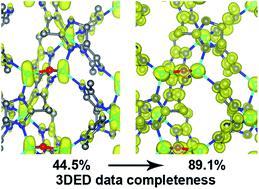当前位置:
X-MOL 学术
›
Faraday Discuss.
›
论文详情
Our official English website, www.x-mol.net, welcomes your
feedback! (Note: you will need to create a separate account there.)
On the completeness of three-dimensional electron diffraction data for structural analysis of metal–organic frameworks
Faraday Discussions ( IF 3.3 ) Pub Date : 2021-05-04 , DOI: 10.1039/d1fd00020a Meng Ge 1 , Taimin Yang 1 , Yanzhi Wang 2 , Francesco Carraro 3 , Weibin Liang 4 , Christian Doonan 4 , Paolo Falcaro 3 , Haoquan Zheng 2 , Xiaodong Zou 1 , Zhehao Huang 1
Faraday Discussions ( IF 3.3 ) Pub Date : 2021-05-04 , DOI: 10.1039/d1fd00020a Meng Ge 1 , Taimin Yang 1 , Yanzhi Wang 2 , Francesco Carraro 3 , Weibin Liang 4 , Christian Doonan 4 , Paolo Falcaro 3 , Haoquan Zheng 2 , Xiaodong Zou 1 , Zhehao Huang 1
Affiliation

|
Three-dimensional electron diffraction (3DED) has been proven as an effective and accurate method for structure determination of nano-sized crystals. In the past decade, the crystal structures of various new complex metal–organic frameworks (MOFs) have been revealed by 3DED, which has been the key to understand their properties. However, due to the design of transmission electron microscopes (TEMs), one drawback of 3DED experiments is the limited tilt range of goniometers, which often leads to incomplete 3DED data, particularly when the crystal symmetry is low. This drawback can be overcome by high throughput data collection using continuous rotation electron diffraction (cRED), where data from a large number of crystals can be collected and merged. Here, we investigate the effects of improving completeness on structural analysis of MOFs. We use ZIF-EC1, a zeolitic imidazolate framework (ZIF), as an example. ZIF-EC1 crystallizes in a monoclinic system with a plate-like morphology. cRED data of ZIF-EC1 with different completeness and resolution were analyzed. The data completeness increased to 92.0% by merging ten datasets. Although the structures could be solved from individual datasets with a completeness as low as 44.5% and refined to a high precision (better than 0.04 Å), we demonstrate that a high data completeness could improve the structural model, especially on the electrostatic potential map. We further discuss the strategy adopted during data merging. We also show that ZIF-EC1 doped with cobalt can act as an efficient electrocatalyst for oxygen reduction reactions.
中文翻译:

用于金属-有机骨架结构分析的三维电子衍射数据的完整性
三维电子衍射 (3DED) 已被证明是一种有效且准确的纳米晶体结构测定方法。在过去的十年中,3DED 揭示了各种新型复杂金属有机骨架 (MOF) 的晶体结构,这一直是了解其性质的关键。然而,由于透射电子显微镜 (TEM) 的设计,3DED 实验的一个缺点是测角仪的倾斜范围有限,这通常会导致 3DED 数据不完整,尤其是当晶体对称性较低时。这个缺点可以通过使用连续旋转电子衍射 (cRED) 的高通量数据收集来克服,其中可以收集和合并来自大量晶体的数据。在这里,我们研究了提高完整性对 MOF 结构分析的影响。我们使用 ZIF-EC1,一种沸石咪唑酯骨架 (ZIF),作为示例。ZIF-EC1 在具有板状形态的单斜晶系中结晶。分析了具有不同完整性和分辨率的 ZIF-EC1 的 cRED 数据。通过合并十个数据集,数据完整性提高到 92.0%。尽管可以从单个数据集以低至 44.5% 的完整性求解结构并精制到高精度(优于 0.04 Å),但我们证明了高数据完整性可以改进结构模型,尤其是在静电势图上。我们进一步讨论了数据合并过程中采用的策略。我们还表明,掺杂钴的 ZIF-EC1 可以作为氧还原反应的有效电催化剂。ZIF-EC1 在具有板状形态的单斜晶系中结晶。分析了具有不同完整性和分辨率的 ZIF-EC1 的 cRED 数据。通过合并十个数据集,数据完整性提高到 92.0%。虽然结构可以从单个数据集以低至 44.5% 的完整性求解并精制到高精度(优于 0.04 Å),但我们证明了高数据完整性可以改进结构模型,尤其是在静电势图上。我们进一步讨论了数据合并过程中采用的策略。我们还表明,掺杂钴的 ZIF-EC1 可以作为氧还原反应的有效电催化剂。ZIF-EC1 在具有板状形态的单斜晶系中结晶。分析了具有不同完整性和分辨率的 ZIF-EC1 的 cRED 数据。通过合并十个数据集,数据完整性提高到 92.0%。虽然结构可以从单个数据集以低至 44.5% 的完整性求解并精制到高精度(优于 0.04 Å),但我们证明了高数据完整性可以改进结构模型,尤其是在静电势图上。我们进一步讨论了数据合并过程中采用的策略。我们还表明,掺杂钴的 ZIF-EC1 可以作为氧还原反应的有效电催化剂。尽管可以从单个数据集以低至 44.5% 的完整性求解结构并精制到高精度(优于 0.04 Å),但我们证明了高数据完整性可以改进结构模型,尤其是在静电势图上。我们进一步讨论了数据合并过程中采用的策略。我们还表明,掺杂钴的 ZIF-EC1 可以作为氧还原反应的有效电催化剂。尽管可以从单个数据集以低至 44.5% 的完整性求解结构并精制到高精度(优于 0.04 Å),但我们证明了高数据完整性可以改进结构模型,尤其是在静电势图上。我们进一步讨论了数据合并过程中采用的策略。我们还表明,掺杂钴的 ZIF-EC1 可以作为氧还原反应的有效电催化剂。
更新日期:2021-07-06
中文翻译:

用于金属-有机骨架结构分析的三维电子衍射数据的完整性
三维电子衍射 (3DED) 已被证明是一种有效且准确的纳米晶体结构测定方法。在过去的十年中,3DED 揭示了各种新型复杂金属有机骨架 (MOF) 的晶体结构,这一直是了解其性质的关键。然而,由于透射电子显微镜 (TEM) 的设计,3DED 实验的一个缺点是测角仪的倾斜范围有限,这通常会导致 3DED 数据不完整,尤其是当晶体对称性较低时。这个缺点可以通过使用连续旋转电子衍射 (cRED) 的高通量数据收集来克服,其中可以收集和合并来自大量晶体的数据。在这里,我们研究了提高完整性对 MOF 结构分析的影响。我们使用 ZIF-EC1,一种沸石咪唑酯骨架 (ZIF),作为示例。ZIF-EC1 在具有板状形态的单斜晶系中结晶。分析了具有不同完整性和分辨率的 ZIF-EC1 的 cRED 数据。通过合并十个数据集,数据完整性提高到 92.0%。尽管可以从单个数据集以低至 44.5% 的完整性求解结构并精制到高精度(优于 0.04 Å),但我们证明了高数据完整性可以改进结构模型,尤其是在静电势图上。我们进一步讨论了数据合并过程中采用的策略。我们还表明,掺杂钴的 ZIF-EC1 可以作为氧还原反应的有效电催化剂。ZIF-EC1 在具有板状形态的单斜晶系中结晶。分析了具有不同完整性和分辨率的 ZIF-EC1 的 cRED 数据。通过合并十个数据集,数据完整性提高到 92.0%。虽然结构可以从单个数据集以低至 44.5% 的完整性求解并精制到高精度(优于 0.04 Å),但我们证明了高数据完整性可以改进结构模型,尤其是在静电势图上。我们进一步讨论了数据合并过程中采用的策略。我们还表明,掺杂钴的 ZIF-EC1 可以作为氧还原反应的有效电催化剂。ZIF-EC1 在具有板状形态的单斜晶系中结晶。分析了具有不同完整性和分辨率的 ZIF-EC1 的 cRED 数据。通过合并十个数据集,数据完整性提高到 92.0%。虽然结构可以从单个数据集以低至 44.5% 的完整性求解并精制到高精度(优于 0.04 Å),但我们证明了高数据完整性可以改进结构模型,尤其是在静电势图上。我们进一步讨论了数据合并过程中采用的策略。我们还表明,掺杂钴的 ZIF-EC1 可以作为氧还原反应的有效电催化剂。尽管可以从单个数据集以低至 44.5% 的完整性求解结构并精制到高精度(优于 0.04 Å),但我们证明了高数据完整性可以改进结构模型,尤其是在静电势图上。我们进一步讨论了数据合并过程中采用的策略。我们还表明,掺杂钴的 ZIF-EC1 可以作为氧还原反应的有效电催化剂。尽管可以从单个数据集以低至 44.5% 的完整性求解结构并精制到高精度(优于 0.04 Å),但我们证明了高数据完整性可以改进结构模型,尤其是在静电势图上。我们进一步讨论了数据合并过程中采用的策略。我们还表明,掺杂钴的 ZIF-EC1 可以作为氧还原反应的有效电催化剂。











































 京公网安备 11010802027423号
京公网安备 11010802027423号